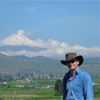
 |
Early human settlement in the Americas |
Professor Matthew Bennett (Environmental & Geographical Sciences Group) has just returned from three weeks of fieldwork in Mexico part of his NERC fund project ?Early human settlement in the Americas?.
He has been working on the Quaternary stratigraphy of the Valsequillo Basin in Central Mexico. Understanding the sedimentary geology of this basin, which was occupied during the Quaternary by a large lake and filled by a variety of volcanic debris, is central to providing a stratigraphic and geochronological framework in which to contextualise the archaeology of this region. This includes controversial human footprints which might provide some of the first evidence of colonisation of the Americas.



From left to right: Professor Bennett pictured with a large leg bone of a mammoth just recovered from sediments within the Valsequillo Basin.
The volcano Popocatepetl which towers above the Valsequillo Basin.
Professor Bennett sampling organic sediments from the Valsequillo Basin. These samples will be used to reconstruct the vegetation history of the basin from the pollen grains preserved in the sediment.
Professor Bennett has spent the last few weeks logging sections and collecting palaeo-environment data including the remains of large mega-fauna such as the remains of extinct mammoth and camel as well freshwater and land molluscs. The fossil remains in conjunction with the sedimentology of the basin will allow a detailed palaeo-environmental model to be developed in time.

Sample bag showing a collection of molluscs used in palaeo-environmental reconstruction.
The work in ongoing and further fieldwork is planned for 2007.
22/08/06